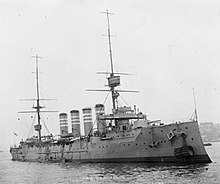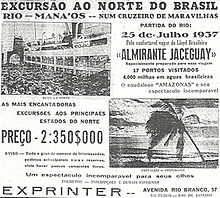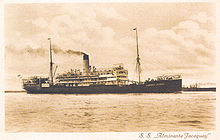Professor Woermann (Schiff, 1912)
|
Professor Woermann as a professor in the British service
|
||||||||||||||||||||||
|
||||||||||||||||||||||
|
||||||||||||||||||||||
|
||||||||||||||||||||||
|
||||||||||||||||||||||
The Professor Woermann of the Woermann Line was built in 1912 as a replica of the Henny Woermann completed in 1911 by the Reiherstieg shipyard for passenger, freight and postal services to the West African German protected areas Togo and Cameroon and possibly also to German South West Africa .
The Professor Woermann was hijacked by Great Britain in 1914 and continued to be used under the name of Professor . In 1922 the ship came under the German flag again as General San Martin for the Hugo Stinnes Line . It was used on cruises to South America and from 1923 as the first German ship after the World War .
In 1926 the ship was sold to the state shipping company Lloyd Brasileiro in Brazil and continued to sail as Almirante Jaceguay . It was not until 1958 that the ship was scrapped.
history
Since 1898 the Woermann line has operated five lines to West and South West Africa. Since 1900 the Woermann-Linie had also commissioned passenger ships as newbuildings. The last new passenger ships built by the shipping company before the First World War were the sister ships Henny Woermann and Professor Woermann , which were completed at the Reiherstieg shipyard in 1911 and 1912 and were deployed to West Africa. They were the largest ships of the shipping company in the West Africa service, which Woermann-Linie and Hapag last operated with thirteen lines. The new passenger steamers served the so-called express service from Hamburg to Cameroon .
The sister ships were two-masted single chimneys with high and large deck houses and a relatively high structure at the stern. The drive of the two new buildings consisted of a quadruple expansion machine with five cylinders of 3800 HP on one shaft. The imperial post steamers Adolph Woermann and Gertrud Woermann of 6268 and 6465 GRT with twin screw drives and smaller passenger facilities were slightly larger. They were used by Woermann on the "Rund um-Afrika" mail line .
The Professor Woermann , completed in 1912, was the third ship of the shipping company of this name. In 1882 the shipping company first received a 1611 GRT steamer from Blohm & Voss as the first bearer of the name, which was sold to Italy in 1903 and then on to Brazil.
From 1904 the shipping company again had a Professor Woermann by renaming the 5638 GRT Florida acquired by Argo Reederei . In 1907 she left the Woermann Line when she was given over to Hapag as part of the establishment of a joint service and remained there as Swakopmund in West Africa until the start of the war . The Woermann Line acquired three ships of this type in 1904/1905. The sister ships Eduard Woermann (ex Alabama ) and Erna Woermann (ex Louisiana ) remained in West Africa service alongside the Swakopmund of Hapag until 1914. The three ships were only given a passenger facility for around 100 passengers after they were taken over into the Africa service.
Mission history
The Professor Woermann took in September 1912 their service in 1911 introduced fast service to Cameroon. The ships serving this service from Hamburg called at Dover , Boulogne , Madeira , Las Palmas , Conakry , Freetown , Monrovia , Grand Bassa , Sekondi , Accra , Lome (capital of the German colony of Togo ), Lagos , Victoria, Kribi , Plantation and Longji, before they reached Duala . On the way back, Tenerife was also called .
When the war broke out in 1914, Professor Woermann , who was on her way home, was in Tenerife and was ordered to Las Palmas to bring her passengers ashore. She took over coal and provisions to supply German warships in the Atlantic. She ran into the area around Cape Verde , where on August 27 the British armored cruiser HMS Carnarvon surprised the ship and brought it up. The armored cruiser brought the ship to Freetown . First the confiscated ship was ordered to Cape Town to transport South African troops to Europe, then managed by the Union-Castle Line and used as a professor on the side of the Allies until the end of the war .
Cruise ship
After the war, the ship was bought in 1921 by Hugo Stinnes AG in Hamburg , who wanted to use it in South America under the name Edmund Wagenknecht . On April 5, 1922, the ship was renamed General San Martin , before it went on a test drive for the first time on August 5 and then was used to South America. The General San Martin was the only three-class ship of the newly established South America service of the shipping company, which with the General Belgrano ex Bahia Castillo and Holm ex Badenia also used typical emigrant ships (without 1st class) and freighters .
In 1923 the passenger facility was rebuilt and, in addition to a luxurious first class, a new III. Cabin class with 88 seats set up for use as a cruise ship .
In June 1923, the General San Martin became the first German ship to make two cruises to Norway after the World War. In February 1924, a trip via Madeira to Tenerife and back via Ceuta , Málaga and Lisbon to Hamburg was also offered. Then there were two more Nordland rides on which the General San Martin on August 5, 1924 as the first German ship after World War Spitsbergen delivery points. In 1925 the cruise service was expanded again. A three-part trip to the south was offered from February 1st to May 12th, which first led to Tenerife and back to Venice . The second part consisted of a Mediterranean trip to Cattaro , Port Said , Constantinople , Athens , Messina , Algiers , Barcelona and Genoa . The third section from Genoa led back to Istanbul, left out the Adriatic and led from Algiers via Málaga and Lisbon back to Hamburg. The trip could also be booked in the sections. After the two summer trips to Norway and Spitsbergen, the ship's use as a cruise ship ended.
When in 1926 the Stinnes Line first merged with Austral-Kosmos and then with Hapag, the ship had already been sold to Lloyd Braileiro in June 1926 because Austral-Kosmos did not want to continue the cruise business.
Under the Brazilian flag
The Brazilian shipping company started the ship as Almirante Jaceguay ; She had previously operated the sister ship Henny Woermann , which was confiscated in Brazil in 1917, as Uberaba until 1921, which was stranded on March 27, 1921 on a return voyage from New York off the Brazilian north coast of Maranhão and then broke. The ship was named after the Brazilian admiral Arthur Silveira da Motta, Baron Jaceguay (1843-1914), one of the initiators of the establishment of a transatlantic Brazilian shipping company. The Almirante Jaceguay ex General San Martin ex Professor Woermann was a relatively luxuriously furnished ship and was used in passenger service on the route from Buenos Aires to Europe and collided with the British RMS Silarus on the Scheldt in August 1927 . In the summer of 1930, the elected Brazilian President Júlio Prestes , who was never able to take office , used the ship for a trip to the USA. Later the ship was mainly used for traffic along the Brazilian coast and also offered tourist trips.
In 1958 the Almirante Jaceguay was broken up in Brazil.
| Fate of the sister ship | |||||
|---|---|---|---|---|---|
| Surname | Shipyard | GRT | Launched in service |
further fate | |
| Henny Woermann | Reiherstieg shipyard building number 443 |
6082 | 24.05.1911 08.30.1911 |
1914 walked from Monrovia to Pernambuco without non-German passengers until August 7, confiscated June 2, 1917, used as Uberaba by Lloyd Brasileiro, on March 27, 1921 , coming from New York , stranded in front of Maranhão and then broken. | |
Individual evidence
- ↑ a b c d e Kludas: German Passenger Shipping , Vol. III Abrupt growth 1900-1914 , p. 144
- ↑ Kludas: Ships of the Africa Lines, p. 15
- ↑ Kludas: Ships of the Africa Lines, p. 54
- ↑ Kludas, Vol. III, pp. 151f.
- ↑ Herbert: Kriegsfahrten Deutscher Handelsschiffe , p. 106f.
- ↑ Kludas, Vol. IV Destruction and Rebirth , p. 57
- ↑ Kludas, Vol. IV, pp. 180 ff.
- ↑ Kludas, Vol. IV, pp. 198 ff.
- ↑ Uberaba sinking point ( Memento from January 31, 2014 in the Internet Archive )
- ↑ Herbert, p. 107
- ↑ Kludas: Ships of the Africa Lines , p. 72.
Web links
- Image and text on Almirante Jaceguay and other images (Italian, accessed February 19, 2014)
- Brazilian Cruise Ships Report (Portuguese, accessed February 19, 2014)
- Report on a trip by the elected Brazilian President Júlio Prestes on the Almirante Jaceguay to the USA (Port., Accessed February 19, 2014)
- Further information on the trip and prestes (Portuguese / English, accessed February 19, 2014)
- Travel the Almirante Jaceguay to Buenos Aires with Jewish immigrants from Europe to Argentina (English retrieved., February 19, 2014)
literature
- Carl Herbert: War voyages of German merchant ships . Broschek & Co, Hamburg 1934.
- Arnold Kludas : The ships of the German Africa Lines 1880 to 1945 . Verlag Gerhard Stalling, 1975, ISBN 3-7979-1867-4 .
- Arnold Kludas: The History of German Passenger Shipping Volume II Expansion on All Seas 1890 to 1900 , Writings of the German Shipping Museum, Volume 19
- Arnold Kludas: The History of the German Passenger Shipping Volume III Leap growth 1900 to 1914 , Writings of the German Shipping Museum, Volume 20
- Arnold Kludas: The History of German Passenger Shipping Volume IV Destruction and Rebirth 1914 to 1930 , Writings of the German Shipping Museum, Volume 21
- Hjalmar Schacht: German Mediterranean voyage 1925 on board the D. "General San Martin" of the Hugo Stinnes Linien , 1925




